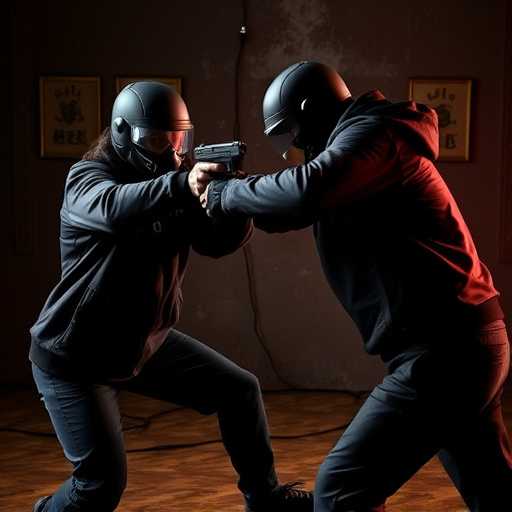Global regulations on riot control agents, particularly pepper spray, focus on determining the strongest legal concentration (typically 2% to 5% capsaicin) to balance crowd control effectiveness with safety. This range ensures non-lethal outcomes while allowing for incapacitation through irritation and pain. International standards, guided by organizations like the UN, govern usage, promoting responsible force deployment and de-escalation tactics as future trends.
Riot control agents, particularly pepper spray, have become indispensable tools for law enforcement worldwide. This article explores the multifaceted world of these agents, delving into their legal frameworks, chemical compositions, and varying concentrations, including the crucial aspect of determining the strongest legal pepper spray concentration. We also examine international regulations and emerging trends shaping their future use.
- Understanding Riot Control Agents: Legal Frameworks
- Pepper Spray: Chemical Composition and Effects
- Determining Legal Pepper Spray Concentration
- Application and Use by Law Enforcement
- International Regulations and Future Trends
Understanding Riot Control Agents: Legal Frameworks
Riot control agents, often referred to as pepper spray, are powerful tools employed by law enforcement agencies for crowd management and disorderly situation resolution. These agents work by irritating the eyes, nose, and respiratory system, temporarily incapacitating individuals and allowing officers to regain control. Understanding the legal frameworks surrounding these substances is paramount for both authorities and citizens alike.
The regulation of riot control agents varies significantly across jurisdictions, with each country or region setting its own standards. One critical aspect is the strongest legal pepper spray concentration permitted. For instance, in many countries, law enforcement agencies are required to use pepper spray with a concentration below 2%, ensuring it remains non-lethal while still providing an effective deterrent. This balance between effectiveness and safety forms the backbone of legal guidelines, aiming to protect both public safety and individual rights during high-tension incidents.
Pepper Spray: Chemical Composition and Effects
Pepper spray, a widely used riot control agent, is a chemical compound designed to incapacitate individuals temporarily through irritation and pain. Its primary active ingredient is capsaicin, derived from chili peppers. The strength of pepper spray is measured in parts per million (ppm), with higher concentrations offering more intense effects. Among legal options, the strongest pepper spray concentration typically ranges between 10% and 25% ppm, ensuring its effectiveness while adhering to legal guidelines.
The 10% to 25% ppm range allows for a balance between potency and safety. Lower concentrations may not provide sufficient incapacitation, while significantly higher ones could potentially cause serious harm if misused. This specific range is carefully calibrated to meet law enforcement needs while minimizing the risk of abuse, making it the standard for legal pepper spray applications.
Determining Legal Pepper Spray Concentration
When it comes to riot control and law enforcement, the effectiveness of pepper spray depends significantly on its concentration. The strongest legal pepper spray concentration varies across jurisdictions due to differing standards and regulations. Typically, it ranges from 2% to 5% capsaicin, the active ingredient responsible for the burning sensation associated with chili peppers.
Law enforcement agencies must balance efficacy with safety, ensuring that the chosen concentration is potent enough to subdue without causing severe health issues. The 2% concentration is considered the upper limit for legal use in many places, aiming for a powerful but controlled response during high-risk situations like riots or crowd control.
Application and Use by Law Enforcement
Law enforcement agencies worldwide employ various riot control agents as non-lethal options for crowd management and control during demonstrations, riots, or high-risk operations. One of the most commonly used tools is pepper spray, which acts as a temporary but potent irritant to the eyes, nose, and respiratory system. The effectiveness of these agents lies in their ability to disrupt and disperse crowds quickly and relatively safely.
When deployed by law enforcement, riot control agents, including legal pepper spray with the strongest concentration available (typically around 2% capsaicin), are used as a last resort when other de-escalation tactics have failed. Officers receive specialized training to ensure safe and responsible usage, minimizing harm to both public safety personnel and civilian bystanders while effectively maintaining order during chaotic situations.
International Regulations and Future Trends
International regulations play a crucial role in governing the use of riot control agents, including pepper spray, to ensure responsible and proportional force by law enforcement. The United Nations and various regional organizations have guidelines and conventions that dictate the development, deployment, and control of chemical agents for security purposes. One key aspect is the regulation of the strongest legal pepper spray concentration, which varies across jurisdictions but typically balances effectiveness with safety to minimize harm to both suspects and bystanders.
Future trends in riot control agent law enforcement point towards more specialized and less harmful substances. Advancements in chemistry and a growing focus on de-escalation tactics are leading to the development of alternative agents that can still disrupt rioting or violent behavior but with reduced health risks. These innovations, coupled with continuous training for officers on non-lethal force options, reflect a broader shift towards more nuanced and human rights-compliant law enforcement practices globally.
Riot control agents, particularly pepper spray, have evolved from rudimentary techniques to sophisticated legal tools for law enforcement. Understanding the chemical composition, effects, and proper concentration like the strongest legal pepper spray concentration is paramount for effective and safe deployment. International regulations continue to shape their use, reflecting a global move towards more responsible and proportionate responses to civil unrest. As technology advances, future trends in riot control agents will likely emphasize non-lethal solutions that prioritize public safety while upholding legal frameworks governing their application.
